Siemens 2005C User Manual
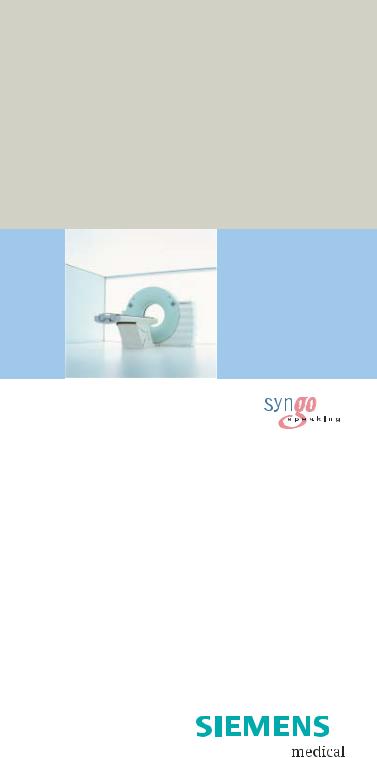
SOMATOM
Spirit
Application Guide
Protocols
Principles
Helpful Hints
syngo 3D
syngo Fly Through syngo Dental CT syngo Osteo CT
syngo Volume Evaluation syngo Dynamic Evaluation
Software Version syngo CT 2005C
The information presented in this Application Guide is for illustration only and is not intended to be relied upon by the reader for instruction as to the practice of medicine. Any health care practitioner reading this information is reminded that they must use their own learning, training and expertise in dealing with their individual patients.
This material does not substitute for that duty and is not intended by Siemens Medical Solutions Inc., to be used for any purpose in that regard. The drugs and doses mentioned are consistent with the approval labeling for uses and/or indications of the drug. The treating physician bears the sole responsibility for the diagnosis and treatment of patients, including drugs and doses prescribed in connection with such use. The Operating Instructions must always be strictly followed when operating the CT System. The source for the technical data is the corresponding data sheets.
The pertaining operating instructions must always be strictly followed when operating the SOMATOM Spirit. The statutory source for the technical data are the corresponding data sheets.
We express our sincere gratitude to the many customers who contributed valuable input.
Special thanks to Heike Theessen, Christiane Bredenhöller, Kristin Pacheco, Karin Ladenburger, and Chen Mahao for their valuable assistance.
To improve future versions of this Application Guide, we would greatly appreciate your questions, suggestions and comments.
Please contact us:
USC-Hotline:
Tel. no.+49-1803-112244
email ct-application.hotline@med.siemens.de
Editor: Ute Feuerlein
2

Overview
|
User Documentation |
14 |
|
Scan and Reconstruction |
16 |
|
||
|
Dose Information |
28 |
|
||
|
||
|
Workflow Information |
36 |
|
||
|
||
|
Application Information |
54 |
|
||
|
||
|
Head |
70 |
|
||
|
||
|
Neck |
88 |
|
||
|
||
|
Shoulder |
94 |
|
||
|
||
|
Thorax |
98 |
|
||
|
||
|
Abdomen |
110 |
|
||
|
||
|
Pelvis |
124 |
|
||
|
||
|
Spine |
132 |
|
||
|
||
|
Upper Extremities |
146 |
|
||
|
||
|
|
|
3

|
Lower Extremities |
154 |
|
Vascular |
162 |
|
||
|
Specials |
176 |
|
||
|
||
|
Children |
184 |
|
||
|
||
|
syngo 3D |
240 |
|
||
|
||
|
syngo Fly Through |
258 |
|
||
|
||
|
syngo Dental CT |
268 |
|
||
|
||
|
syngo Osteo CT |
274 |
|
||
|
||
|
syngo Volume Evaluation |
288 |
|
||
|
||
|
syngo Dynamic Evaluation |
306 |
|
||
|
||
|
|
|
4

5

Contents
|
User Documentation |
14 |
|
|
Scan and Reconstruction |
16 |
|
|
|||
|
• Concept of Scan Protocols |
16 |
|
|
|||
|
• Scan Set Up |
17 |
|
|
• Scan Modes |
18 |
|
- |
Sequential Scanning |
18 |
|
- |
Spiral Scanning |
18 |
|
- |
Dynamic Serioscan |
18 |
|
|
• Slice Collimation and Slice Width |
19 |
|
|
- Slice Collimation and Slice Width for |
|
|
|
|
Spiral Mode and HR Spiral Mode |
20 |
|
- Slice Collimation and Slice Width for |
|
|
|
|
Sequence Mode and HR Sequence Mode |
20 |
|
• Increment |
21 |
|
|
• Pitch |
22 |
|
|
• Window values |
23 |
|
|
• Kernels |
24 |
|
|
• Image Filters |
25 |
|
|
• Improved Head Imaging |
27 |
|
|
Dose Information |
28 |
|
|
|||
|
• CTDIW and CTDIVol |
28 |
|
|
|||
|
• Effective mAs |
30 |
|
|
• CARE Dose |
32 |
|
|
- How does CARE Dose work? |
32 |
|
|
Workflow Information |
36 |
|
|
|||
|
• Recon Jobs |
36 |
|
|
|||
|
• Examination Job Status |
37 |
|
|
• Auto Load in 3D and Post-processing |
|
|
|
Presets |
38 |
|
|
• How to Create your own |
|
|
|
Scan Protocols |
39 |
|
- |
Edit/Save Scan Protocol |
39 |
|
- |
Scan Protocol Manager |
40 |
|
6

Contents
|
• Contrast Medium |
45 |
|
- |
The Basics |
45 |
|
- |
IV Injection |
47 |
|
- |
Bolus Tracking |
48 |
|
- |
Test Bolus using CARE Bolus |
50 |
|
- |
Test Bolus |
51 |
|
|
Application Information |
54 |
|
|
|||
|
• SOMATOM life |
54 |
|
|
|||
- |
General Information |
54 |
|
- |
Key Features |
55 |
|
- |
Description |
56 |
|
- |
Access to Computer Based Training or |
|
|
|
|
Manuals on CD ROM |
57 |
- |
SRS Based Services |
58 |
|
- |
Download of Files |
59 |
|
- |
Contact incl. DICOM Images |
60 |
|
- |
Trial Order and Installation |
62 |
|
|
• Image Converter |
64 |
|
|
• File Browser |
66 |
|
|
• Patient Protocol |
68 |
|
|
Head |
|
70 |
|
|
||
|
• Overview |
70 |
|
|
|||
|
• Hints in General |
71 |
|
- |
Head Kernels |
71 |
|
|
• HeadRoutine |
72 |
|
|
• HeadSeq |
74 |
|
|
• InnerEarHR |
76 |
|
|
• InnerEarHRSeq |
78 |
|
|
• Sinus |
80 |
|
|
• SinusSeq |
82 |
|
|
• Orbita |
84 |
|
|
• Dental |
86 |
|
7

Contents
|
Neck |
88 |
|
• Overview |
88 |
|
• Hints in General |
89 |
|
- Body Kernels |
90 |
|
• Neck |
92 |
|
Shoulder |
94 |
|
||
|
• Overview |
94 |
|
||
|
• Hints in General |
95 |
|
- Body Kernels |
95 |
|
• Shoulder |
96 |
|
Thorax |
98 |
|
||
|
• Overview |
98 |
|
||
|
• Hints in General |
99 |
|
- Body Kernels |
101 |
|
• ThoraxRoutine/ThoraxRoutine08s |
102 |
|
• ThoraxFast |
104 |
|
• ThoraxHRSeq |
106 |
|
• LungLowDose |
108 |
|
Abdomen |
110 |
|
||
|
• Overview |
110 |
|
||
|
• Hints in General |
111 |
|
- Body Kernels |
113 |
|
• AbdomenRoutine/AbdomenRoutine08s |
114 |
|
• AbdomenFast |
116 |
|
• AbdMultiPhase/AbdMultiPhase08s |
118 |
|
• AbdomenSeq |
122 |
8

Contents
|
Pelvis |
124 |
|
• Overview |
124 |
|
• Hints in General |
125 |
|
- Body Kernels |
125 |
|
• Pelvis |
126 |
|
• Hip |
128 |
|
• SI_Joints |
130 |
|
Spine |
132 |
|
||
|
• Overview |
132 |
|
||
|
• Hints in General |
133 |
|
- Body Kernels |
135 |
|
• C-Spine |
136 |
|
• C-SpineSeq |
138 |
|
• Spine |
140 |
|
• SpineSeq |
142 |
|
• Osteo |
144 |
|
Upper Extremities |
146 |
|
||
|
• Overview |
146 |
|
||
|
• Hints in General |
147 |
|
- Body Kernels |
148 |
|
• WristHR |
150 |
|
• ExtrRoutineHR |
152 |
|
Lower Extremities |
154 |
|
||
|
• Overview |
154 |
|
||
|
• Hints in General |
155 |
|
- Body Kernels |
156 |
|
• KneeHR |
158 |
|
• FootHR |
160 |
|
• ExtrRoutineHR |
161 |
9

Contents
|
Vascular |
162 |
|
|
• Overview |
162 |
|
|
• Hints in General |
163 |
|
- |
Head Kernels |
163 |
|
- |
Body Kernels |
163 |
|
|
• HeadAngio/HeadAngio08s |
164 |
|
|
• CarotidAngio/CarotidAngio08s |
166 |
|
|
• ThorAngio/ThorAngio08s |
168 |
|
|
• Embolism |
170 |
|
|
• BodyAngioRoutine/BodyAngioRoutine08s 172 |
||
|
• BodyAngioFast |
174 |
|
|
Specials |
176 |
|
|
|||
|
• Overview |
176 |
|
|
|||
- |
Trauma |
176 |
|
- |
Interventional CT |
176 |
|
- |
Test Bolus |
176 |
|
|
• Trauma |
177 |
|
- |
The Basics |
177 |
|
|
• PolyTrauma |
178 |
|
|
• HeadTrauma |
180 |
|
|
• Interventional CT |
181 |
|
|
• Biopsy |
182 |
|
|
• TestBolus |
183 |
|
|
Children |
184 |
|
|
|||
|
• Overview |
184 |
|
|
|||
|
• Hints in General |
187 |
|
- |
Head Kernels |
190 |
|
- |
Body Kernels |
191 |
|
|
• HeadRoutine_Baby |
192 |
|
|
• HeadRoutine_Child |
194 |
|
|
• HeadSeq_Baby |
196 |
|
|
• HeadSeq_Child |
198 |
|
|
• InnerEar |
200 |
|
|
• SinusOrbi |
202 |
|
|
• Neck |
204 |
|
10

Contents
|
• ThoraxRoutine_Baby |
206 |
|
|
• ThoraxRoutine_Child |
208 |
|
|
• ThoraxHRSeq_Baby |
210 |
|
|
• ThoraxHRSeq_Child |
212 |
|
|
• Abdomen_Baby |
214 |
|
|
• Abdomen_Child |
216 |
|
|
• Spine_Baby |
218 |
|
|
• Spine_Child |
220 |
|
|
• ExtrHR_Baby |
222 |
|
|
• ExtrHR_Child |
224 |
|
|
• HeadAngio |
226 |
|
|
• HeadAngio08s |
228 |
|
|
• CarotidAngio |
230 |
|
|
• CarotidAngio08s |
232 |
|
|
• BodyAngio |
234 |
|
|
• BodyAngio08s |
236 |
|
|
• NeonateBody |
238 |
|
|
syngo 3D |
240 |
|
|
|||
|
- Multi Planar Reconstruction (MPR) |
240 |
|
|
|||
|
- Maximum Intensity Projection (MIP) |
240 |
|
|
- Shaded Surface Display (SSD) |
241 |
|
|
- Volume Rendering Technique (VRT) |
241 |
|
- |
Prerequisites |
242 |
|
|
• Workflow |
242 |
|
- |
Loading the Images |
242 |
|
- |
Creating Series |
244 |
|
- |
Editing |
246 |
|
- |
Documentation of Results |
249 |
|
|
• Workflow for a CT Extremity Examination |
250 |
|
- |
Using MPR/MPR Thick |
250 |
|
- |
Using SSD |
251 |
|
- |
Using VRT |
251 |
|
|
• Workflow for a CT Angiography |
252 |
|
- |
Using MIP/MIP Thin |
252 |
|
- |
Using VRT/VRT Thin/Clip |
253 |
|
|
• Hints in General |
254 |
|
|
- Setting Views in the Volume Data Set |
254 |
|
|
- Changing /Creating VRT Presets |
255 |
|
11

Contents
|
- Auto Load in 3D and Post-processing |
|
|
|
|
Presets |
257 |
- |
Blow-up Mode |
257 |
|
|
syngo Fly Through |
258 |
|
|
|||
|
• Key Features |
258 |
|
|
|||
|
• Prerequisites |
259 |
|
|
• The Basics for CT Virtual Endoscopy |
259 |
|
|
- SSD and VRT Presets for Endoscopic |
|
|
|
|
Renderings |
259 |
- |
Endoscopic Viewing Parameters/ |
|
|
|
|
Fly Cone Settings |
260 |
- |
Patient Preparation |
262 |
|
|
• Workflow |
263 |
|
|
- Navigation of the Endoscopic Volume |
265 |
|
- |
Fly Path Planning |
266 |
|
|
syngo Dental CT |
268 |
|
|
|||
|
• The Basics |
268 |
|
|
|||
|
• Scan Protocols |
269 |
|
|
• Additional Important Information |
271 |
|
|
syngo Osteo CT |
274 |
|
|
|||
|
• The Basics |
274 |
|
|
|||
|
• Scanning Procedure |
275 |
|
|
• Configuration |
278 |
|
|
• Evaluation Workflow |
282 |
|
|
• Additional Important Information |
287 |
|
|
syngo Volume Evaluation |
288 |
|
|
|||
|
• Prerequisites |
290 |
|
|
|||
|
• Workflow |
291 |
|
|
• General Hints |
300 |
|
|
• Configuration |
303 |
|
12

Contents
|
syngo Dynamic Evaluation |
306 |
|
|
• Prerequisites |
308 |
|
|
• Workflow |
309 |
|
|
- 1. Loading the Images |
309 |
|
|
- 2. Inspecting the Input Images |
310 |
|
- 3. |
Generation of Parameter Images |
310 |
|
- 4. |
Creating a Baseline Image |
313 |
|
- 5. |
Evaluation of Region of Interests |
314 |
|
|
- 6. Enhancement Curve |
315 |
|
- 7. |
Documentation of Results |
316 |
|
|
• General Hints |
317 |
|
13

User Documentation
For further information about the basic operation, please refer to the corresponding syngo CT Operator Manual:
syngo CT Operator Manual Volume 1:
Security Package
Basics
Preparations
Examination
CARE Bolus CT
syngo CT Operator Manual Volume 2:
syngo Patient Browser syngo Viewing
syngo Filming syngo 3D
syngo CT Operator Manual Volume 3:
syngo Data Set Conversion syngo Dental CT
syngo Dynamic Evaluation syngo Osteo CT
syngo Volume
14

User Documentation
15

Scan and Reconstruction
Concept of Scan Protocols
The scan protocols for adult and children are defined according to body regions – Head, Neck, Shoulder,
Thorax, Abdomen, Pelvis, Spine, Upper Extremities, Lower Extremities, Specials, and Vascular.
The general concept is as follows: All protocols without suffix are standard spiral modes. E.g., “Shoulder” means the spiral mode for the shoulder.
The suffixes of the protocol name are follows:
“Routine“: for routine studies
“Seq”: for sequence studies
“Fast“: use a higher pitch for fast acquisition
“HR“: use a thinner slice width (1.0 mm) for High Resolution studies and a thicker slice width for soft tissue studies
The availability of scan protocols depends on the system configuration.
16

Scan and Reconstruction
Scan Set Up
Scans can be simply set up by selecting a predefined examination protocol. To repeat any mode, just click the chronicle with the right mouse button for “repeat”. To delete it, select “cut“. Each range name in the chronicle can be easily changed before “load“.
Multiple ranges can be run either automatically with “auto range“, which is denoted by a bracket connecting the two ranges, or separately with a “pause” in between.
17

Scan and Reconstruction
Scan Modes
Sequential Scanning
This is an incremental, slice-by-slice imaging mode in which there is no table movement during data acquisition. A minimum interscan delay in between each acquisition is required to move the table to the next slice position.
Spiral Scanning
Spiral scanning is a continuous volume imaging mode. The data acquisition and table movements are performed simultaneously for the entire scan duration. There is no interscan delay and a typical range can be acquired in a single breath hold.
Each acquisition provides a complete volume data set, from which images with overlapping can be reconstructed at any arbitrary slice position. Unlike the sequence mode, spiral scanning does not require additional radiation to obtain overlapping slices.
Dynamic Serioscan
Dynamic serial scanning mode without table feed. Dynamic serio can still be used for dynamic evaluation, such as Test Bolus.
18

Scan and Reconstruction
Slice Collimation and
Slice Width
Slice collimation is the slice thickness resulting from the effect of the tube-side collimator and the adaptive detector array design. In Multislice CT, the Z-coverage per rotation is given by the product of the number of active detector slices and the collimation (e.g., 2 x 1.0 mm).
Slice width is the FWHM (full width at half maximum) of the reconstructed image.
With the SOMATOM Spirit, you select the slice collimation together with the slice width desired. The slice width is independent of pitch, i.e. what you select is always what you get. Actually, you do not need to be concerned about the algorithm any more; the software does it for you.
The Recon icon on the chronicle will be labeled with “RT”. After the scan, the Real Time displayed image series has to be reconstructed.
The following tables show the possibilities of image reconstruction in spiral and sequential scanning.
19

Scan and Reconstruction
Slice Collimation and Slice Width for Spiral Mode and HR Spiral Mode
1 mm: |
1, 1.25, 2, 3, 5 mm |
1.5 mm: |
2, 3, 5, 6 mm |
2.5 mm: |
3, 5, 6, 8, 10 mm |
4 mm: |
5, 6, 8, 10 mm |
5 mm: |
6, 8, 10 mm |
Slice Collimation and Slice Width for Sequence Mode and HR Sequence Mode
1.0 mm: |
1, 2 mm |
|
1.5 mm: |
1.5, 3 mm |
|
2.5 mm: |
2.5, 5 mm |
|
4.0 mm: |
4, |
8 mm |
5.0 mm |
5, |
10 mm |
20
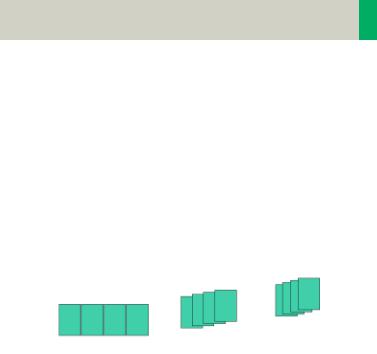
Scan and Reconstruction
Increment
The increment is the distance between the reconstructed images in the Z direction. When the increment chosen is smaller than the slice thickness, the images are created with an overlap. This technique is useful to reduce partial volume effect, giving you better detail of the anatomy and high quality 2D and 3D post-process- ing.
Slice Thickness = 10 mm
|
Increment = 3 mm |
Increment = 10 mm |
Increment = 5 mm |
|
Reconstruction Increment
21

Scan and Reconstruction
Pitch
In single slice CT:
Pitch = table movement per rotation/slice collimation
E.g.,: slice collimation = 5 mm,
table moves 5 mm per rotation, then pitch = 1.
With the Siemens Multislice CT, we differentiate between:
Feed/Rotation, the table movement per rotation
Volume Pitch, table movement per rotation/single slice collimation.
Pitch Factor, table movement per rotation/complete slice collimation.
E.g., slice collimation = 2 x 5 mm, table moves 10 mm per rotation,
then Volume Pitch = 2, Pitch Factor = 1.
With the SOMATOM Spirit, the pitch, slice, collimation, rotation time, and scan range can be adjusted. The pitch factor can be selected from 0.5-2.
Pitch 1 |
Pitch 1.5 |
Pitch 2 |
Pitch Models
22
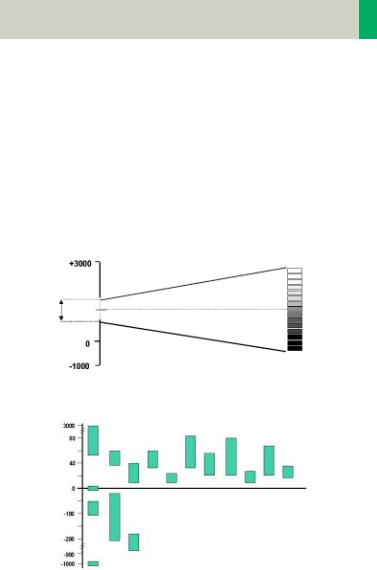
Scan and Reconstruction
Window values
The Scale of the CT Hounsfield Units is from -1024 to +3071.
The displayed window values have to correspond to the anatomical structure.
Windowing is used to optimize contrast and brightness of images.
Hounsfield Units |
|
Gray scale |
|
|
|
|
|
|
|
|
white |
Window |
Window |
|
|
width W |
center C |
|
|
|
|
|
black |
|
|
CT-window values |
|
|
Blood |
Liver |
|
Spleen Kidneys |
Tumor |
||
Heart |
|
||
Bones |
Pancreas Adrenal |
Colon |
Bladder |
|
Glands |
|
|
|
|
|
|
Water
Breast
Fat
Air Lung
Organ specific window values
23

Scan and Reconstruction
Kernels
There are 3 different types of kernels: “H“ stands for Head, “B“ stands for Body, “C“ stands for ChildHead.
The image sharpness is defined by the numbers – the higher the number, the sharper the image; the lower the number, the smoother the image.
A set of 18 kernels is supplied, consisting of:
•6 body kernels: smooth (B20s), medium smooth (B31s), medium (B41s), medium sharp (B50s), sharp (B60s), high res (B70s)
•7 head kernels: smooth (H21s), medium smooth (H31s), medium (H41s), medium sharp (H50s), sharp (H60s), high res (H70s), ultra high res (H80s)
•3 child head kernels: smooth (C20s), medium (C30s), sharp (C60s)
•2 special kernels: S80s, U90s
Note: Do not use different kernels for body parts other than what they are designed for.
For further information regarding the kernels, please refer to the “Hints in General” of the corresponding body region.
24
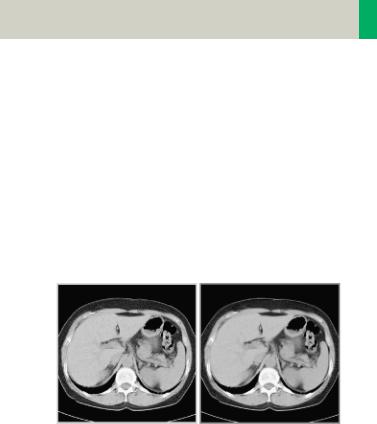
Scan and Reconstruction
Image Filters
There are 3 different filters available:
LCE: The Low-contrast enhancement (LCE) filter enhances low-contrast detectability. It reduces the image noise.
•Similar to reconstruction with a smoother kernel
•Reduces noise
•Enhances low-contrast detectability
•Adjustable in four steps
•Automatic post-processing
25
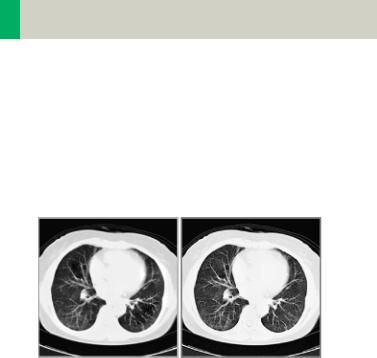
Scan and Reconstruction
HCE: The High-contrast enhancement (HCE) filter enhances high-contrast detectability. It increases the image sharpness, similar to reconstruction with a sharper kernel.
•Increases sharpness
•Faster than raw-data reconstruction
•Enhances high-contrast detectability
•Automatic post-processing
ASA: The Advanced Smoothing Algorithm (ASA) filter reduces noise in soft tissue, while edges with high contrast are preserved.
•Reduces noise without blurring of edges
•Enhances low-contrast detectability
•Individually adaptable
•Automatic post-processing
26

Scan and Reconstruction
Improved Head Imaging
An automatic bone correction algorithm has been included in the standard image reconstruction. Using a new iterative technique, typical artifacts arising from the beam-hardening effect, e.g., Hounsfield bar, are minimized without any additional post-processing. This advanced algorithm allows for excellent images of the posterior fossa, but also improves head image quality in general. Bone correction is activated automatically for body region “Head”.
In order to optimize image quality versus radiation dose, scans in the body region “Head” are provided within a maximum scan field of 300 mm with respect to the iso-center. No recon job with a field of view exceeding those limits will be possible. Therefore, patient positioning has to be performed accurately to ensure a centered location of the skull.
Head image without correction.
Head image with corrections.
27

Dose Information
CTDIW and CTDIVol
The average dose in the scan plane is best described by the CTDIW for the selected scan parameters. The CTDIW is measured in the dedicated plastic phantoms – 16 cm diameter for head and 32 cm diameter for body (as defined in IEC 60601 –2 – 44). This dose number gives a good estimate for the average dose applied in the scanned volume as long as the patient size is similar to the size of the respective dose phantoms.
Since the body size can be smaller or larger than
32 cm, the CTDIW value displayed can deviate from the dose in the scanned volume.
The CTDIW definition and measurement is based on single axial scan modes. For clinical scanning, i.e. scanning of entire volumes in patients, the average dose will also depend on the table feed in between axial scans or the feed per rotation in spiral scanning. The dose, expressed as the CTDIW, must therefore be corrected by the Pitch Factor of the spiral scan or an axial scan series to describe the average dose in the scanned volume.
For this purpose the IEC defined the term “CTDIVol“ in September 2002:
CTDIVol = CTDIW/Pitch Factor
This dose number is displayed on the user interface for the selected scan parameters.
28

Dose Information
The CTDIvol value does not provide the entire information of the radiation risk associated with CT examination. For the purpose, the concept of the “Effective Dose“ was introduced by ICRP (International Commission on Radiation Protection). The effective dose is expressed as a weighted sum of the dose applied not only to the organs in the scanned range, but also to the rest of the body. It could be measured in whole body phantoms (Alderson phantom) or simulated with Monte Carlo techniques.
The calculation of the effective dose is rather complicated and has to be done by sophisticated programs. These have to take into account the scan parameters, the system design of individual scanner, such as x-ray filtration and gantry geometry, the scan range, the organs involved in the scanned range and the organs affected by scattered radiation. For each organ, the respective dose delivered during the CT scanning has to be calculated and then multiplied by its radiation risk factor. Finally, the weighted organ dose numbers are added up to get the effective dose.
The concept of effective dose allows the comparison of radiation risk associated with different CT or x-ray exams, i.e. different exams associated with the same effective dose would have the same radiation risk for the patient. It also allows comparing the applied x-ray exposure to the natural background radiation,
e.g., 2 – 3 mSv per year in Germany.
29

Dose Information
Effective mAs
In sequential scanning, the dose (Dseq) applied to the patient is the product of the tube current-time (mAs) and the CTDIw per mAs:
Dseq = DCTDIw x mAs
In spiral scanning, however, the applied dose (Dspiral) is influenced by the “classical“ mAs (mA x Rot Time) and in addition by the Pitch Factor. For example, if a Multislice CT scanner is used, the actual dose applied to the patient in spiral scanning will be decreased when the Pitch Factor is larger than 1, and increased when the Pitch Factor is smaller than 1. Therefore, the dose in spiral scanning has to be corrected by the Pitch Factor:
Dspiral = (DCTDIw x mA x Rot Time)/Pitch Factor
To make it easier for the users, the concept of the “effective“ mAs was introduced with the SOMATOM Multislice scanners.
The effective mAs takes into account the influence of pitch on both the image quality and dose:
Effective mAs = mAs/Pitch Factor
To calculate the dose you simply have to multiply the CTDIw per mAs with the effective mAs of the scan:
Dspiral = DCTDIw x effective mAs
30
